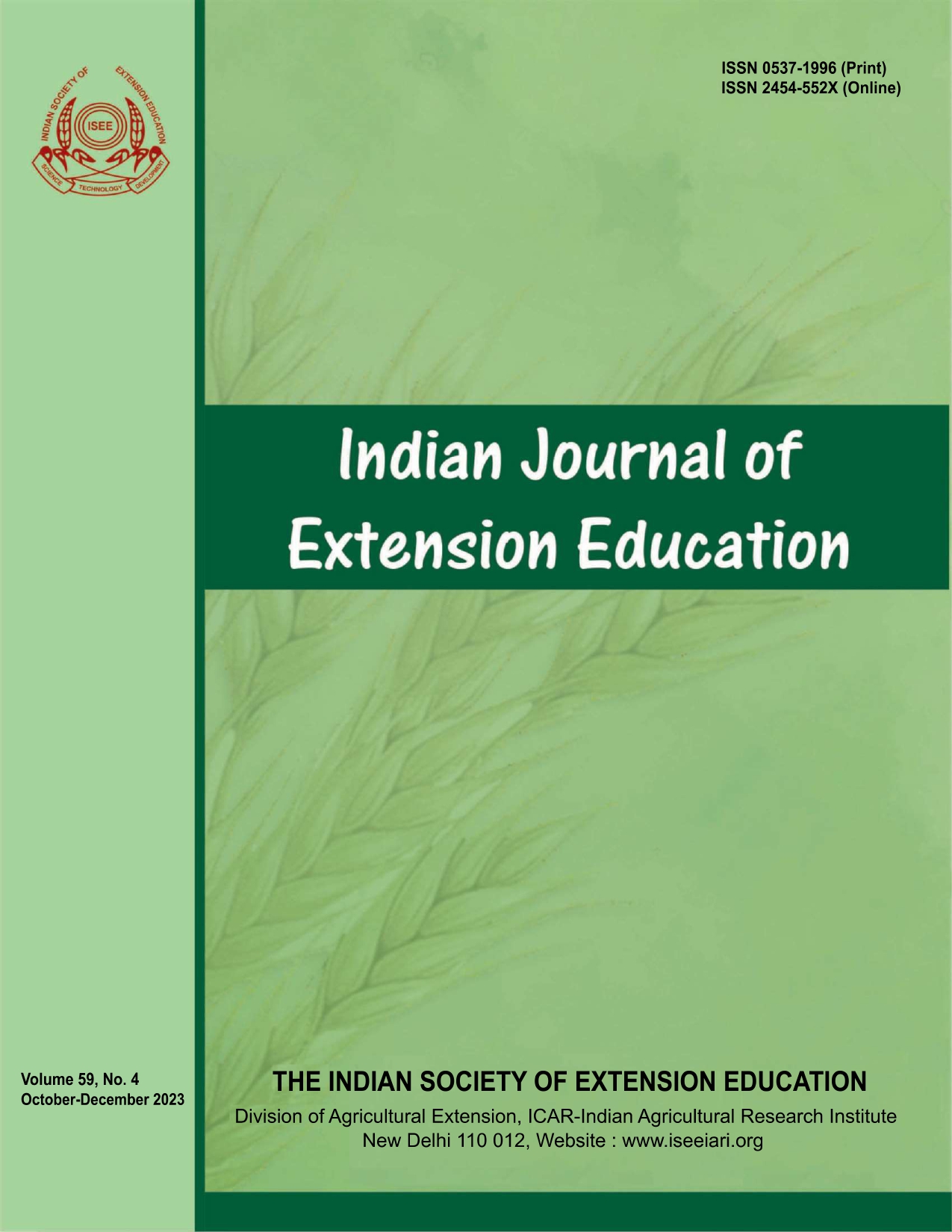Cost and Return Analysis of Tomato Cultivation in Haryana
DOI:
https://doi.org/10.48165/IJEE.2023.59404Keywords:
ost and return, Fixed cost, Cost of production, Cost of cultivation, Tomato cultivation, Variable costAbstract
The study was carried out in Yamuna Nagar, Kurukshetra, and Karnal districts of Haryana during 2021-22. A total of 210 tomato growers were interviewed to collect data to study the thorough cost and return analysis of tomato cultivation. Tomato cultivation was a profitable venture for farmers with a BC ratio of 1: 1.86. The per hectare cost of cultivation was worked out to be Rs. 305701.14 of which major contributors were rental value of land (24.96%), picking/harvesting charges (15.44%), transportation (11.61%) and nursery raising/seed (5.74%). The gross return, return over variable cost and net return per hectare were Rs. 569528.28, 412210.72, and 263827.14 on an overall basis. The production cost per quintal of tomato was computed to be Rs. 707.23 per quintal. It was suggested that farmers should take tomato cultivation with a business and market-oriented approach to compete with the challenges of the glut situation and opt cooperative approach in the production and selling of crops to avail maximum profit by reducing the cost of inputs and transportation and ultimately improving bargaining and negotiating power for better price availing.
Downloads
References
Agarwal, P. K., & Banerjee, A. (2019). Economic analysis of tomato cultivation in Kandi block of West-Bengal, India. Economic Affairs, 64(3), 643-647.
Bhardwaj, R. K., Sikka, B. K., Sharma, M. L., Singh, A. & Singh, N. K. (2011). Sustainable agriculture for increasing efficiency of tomato - value chain in Uttarakhand (India). International Conference on Technology and Business Management, 2(1), 15- 26.
Dastagiri, M. B., Chand, R., Immanuelraj, T. K., Hanumanthaiah, C. V., Paramsivam, P., Sidhu, R. S., Sudha, M., Mandal, S., Singh, B., Chand, K., & Kumar, B. G. (2013). Indian vegetables: production trends, marketing efficiency and export competitiveness. American Journal of Agriculture and Forestry, 1(1), 1-11.
Dubey, S. K., Singh, R., Raut, A. A., Kolekar, D. V., & Athare, T. (2023). Effect of assured transit time for perishable farm produce on enhancing farmers’ income: a case study of kisan rail in
context of Mann ki Baat. Indian Journal of Extension Education, 59(3), 1-6.
Gaikwad, L. D., Nagargoje, S. R., Pathrikar, D. T., & Pariskar, G. R. (2020). Economic analysis of kharif tomato production in Nashik district of Maharashtra State. International Journal of Current Microbiology and Applied Sciences, 11(1), 2288-2292.
Kondal, K. (2017). An Empirical analysis of cost and returns of tomato cultivation in Telangana State. International Journal of Academic Research, 4(3), 132-143.
Kumar, A., Singh, S., Paliwal, G., Singh, A. K., & Chaurasia, S. (2020). Analysis of constraints faced by vegetables growers in production of rabi Season vegetables. Indian Journal of Extension Education, 56(4), 181-185.
Kumar, P., Chauhan, R. S., & Grover, R. K. (2016). Economic analysis of tomato cultivation under poly house and open field conditions in Haryana, India. Journal of Applied and Natural Science, 8(2), 846-848.
Kumari, N., Chahal, P., & Malik, J. S. (2022). Analysis of marketing facilities available for tomato growers of Haryana. Indian Journal of Extension Education, 58(2), 86-90.
Kushwaha, P., Chaudhri, H. P. S., Verma, R. R., & Kushwaha, R. R. (2018). Cost and income analysis of tomato cultivation in Ghazipur district of Uttar Pradesh, India. International Journal of Current Microbiology and Applied Sciences, 7(7), 1566-1572.
Mango, N., Mapemba, L., Tchale, H., Makate, C., Dunjana, N., & Lundy, M. (2015). Comparative analysis of tomato value chain competitiveness in selected areas of Malawi and Mozambique. Cogent Economics and Finance, 3(1), 1-15.
Nain, M. S., Singh, R., Mishra, J. R., Sharma, J. P., Singh, A. K., Kumar, A., Gills, R., & Suman, R. S. (2019). Maximising farm profitability through entrepreneurship development and farmers’ innovations: feasibility analysis and action interventions. Indian Journal of Agricultural Sciences, 89(6), 1044-49.
Sai, K. S., Gayathri, P., Ashok, K., Sri, R., & Raj, B. M. U. (2022). Economic analysis of tomato cultivation. Biological Forum- An International Journal, 14(2), 381-383.
Samshunnahar, M., Khanum, R., & Serajul, M. I. (2016). Profitability of small-scale tomato production in some selected areas in Bangladesh. The Agriculturists, 14(1), 73-82.
Shende, N. V., & Meshram, R. R. (2015). Cost benefits analysis and marketing of Tomato. American International Journal of Research in Formal, Applied & Natural Sciences, 11(1), 46-54.
Tambe, P. C., Hile, R. B., & Patare, S. D. (2018). Cost and returns of summer tomato production in Ahmednagar district of Maharashtra. Journal of Pharmacognosy and Phytochemistry, 7(4), 1525-1527.
Vanitha, S. M., Chinnappa, R. B. V., & Gajanana, T. M. (2018). Economic analysis of profitability in tomato productivity at different seasons and market prices: A study in Kolar district of Karnataka. International Journal of Agriculture Sciences, 10(16), 6961-6966.
Downloads
Published
Issue
Section
License

This work is licensed under a Creative Commons Attribution-NonCommercial-NoDerivatives 4.0 International License.


